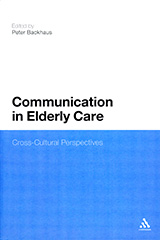
Details
2011, ISBN 978-1-4411-1254-5, Continuum Int. Publishing Group, London, New York, 226 p.Authors
Communication in Elderly Care
Cross-Cultural Perspectives

The topic of communication in elderly care is becoming ever more pressing, with an ageing world population and burgeoning numbers of people needing care. This book looks at this critical but underanalyzed area. It examines the way people talk to each other in eldercare settings from an interdisciplinary and globally cross-cultural perspective.
The small body of available research points to eldercare communication taking place with its own specific conditions and contexts. Often, there is the presence of various mental/physical ailments on the part of the care receivers, scarcity of time, resources and/or flexibility on the part of the care givers, and a mutual necessity of providing/receiving assistance with intimate personal activities.
The book combines theory and practice, with linguistically informed analysis of real-life interaction in eldercare settings across the world. Each chapter closes with a “Practical Recommendations” section that contains suggestions on how communication in eldercare can be improved. The book is an important and timely publication that will appeal to researchers and carers alike.
Content
Elderspeak in Institutional Care for Older Adults
pp. 1-19
Dementia Care Communication in Residential Facilities: In tersections of Training and Research
pp. 20-39
Creating a Positive Communication Environment in Long-Term Care
pp. 40-61
Care of People with Alzheimer's Disease in New Zealand: Supporting the Telling of Life Stories
pp. 62-89
From Home to Institution: Roles, Relations, and the Loss of Autonomy in the Care of Old People in Denmark
pp. 90-111
Cake or Meat?-A Case Study on Dinner Conversations in a Migrant-in-the-Family Household in Germany
pp. 112-128
"Me Nurse, You Resident": Institutional Role-Play in a Japanese Caring Facility
pp. 129-144
Reframing to Regain Identity with Humor: What Conversations with Friends Suggest for Communication in Elderly Care
pp. 145-165
At the INtersection of Art, Alzheimer's Disease, and Discourse: Talk in the Surround of Paintings
pp. 166-192
Using Narrative Arts to Foster Personhood in Dementia
pp.193-217